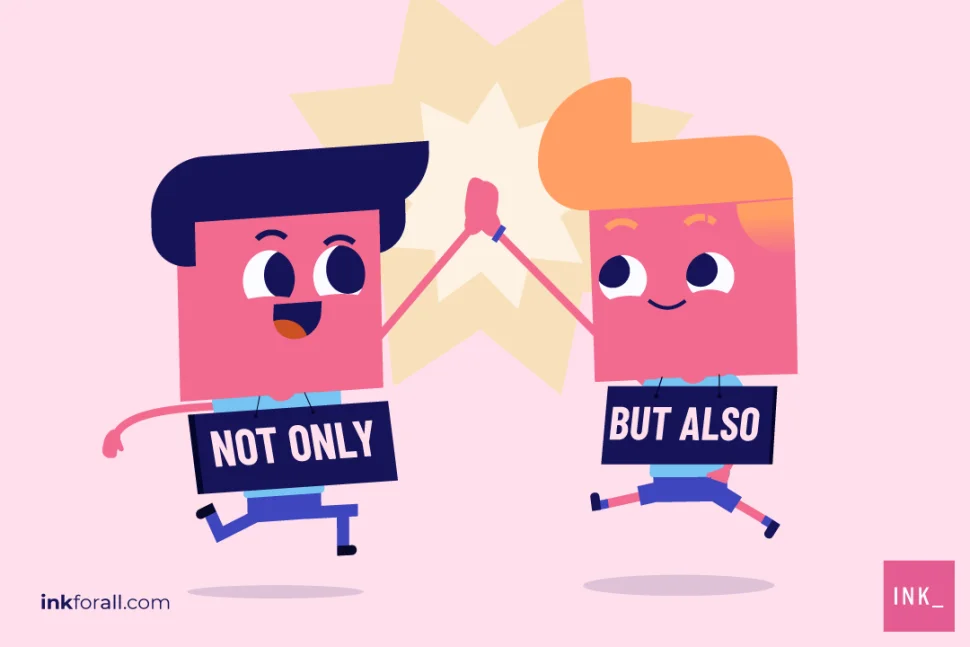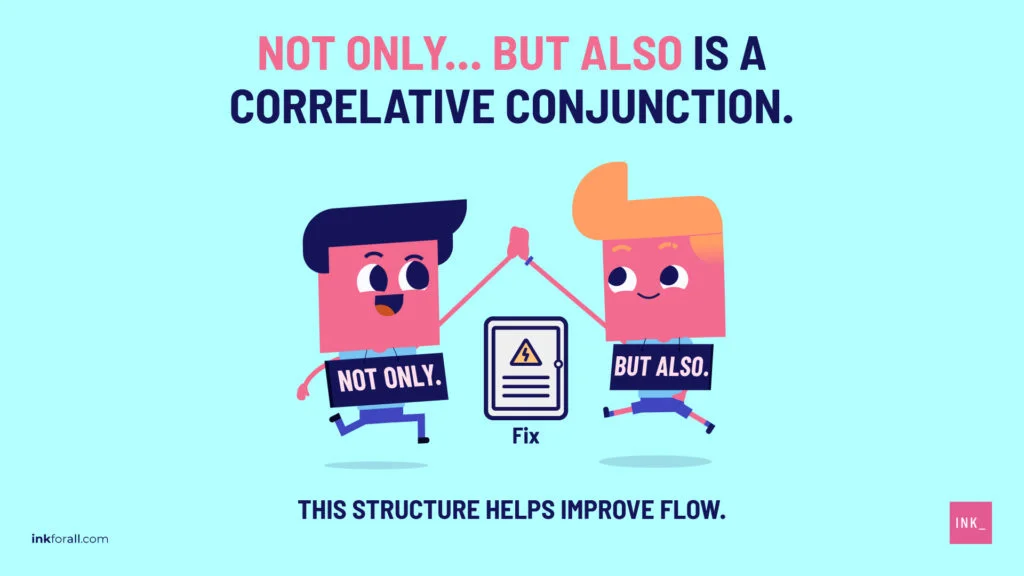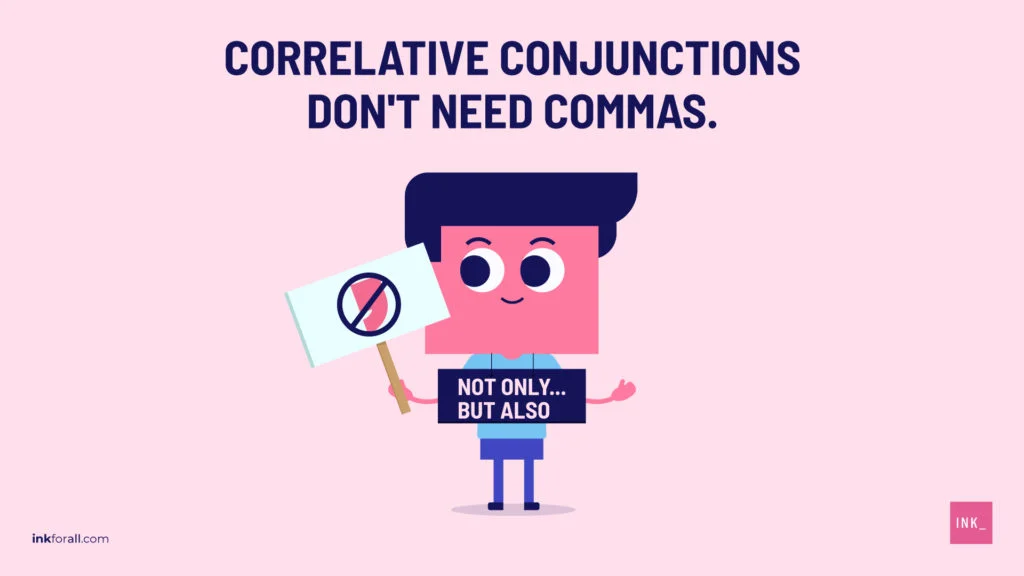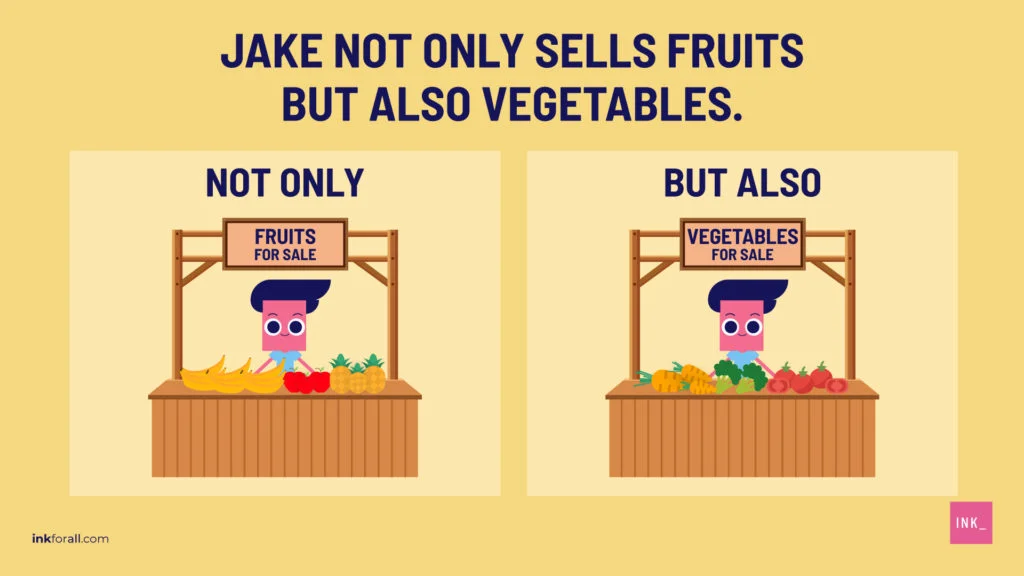Main Not Only But Also Takeaways:
- Not only…but also is a correlative conjunction. This means that this construction helps convey two related facts, thoughts, or pieces of information.
- It expresses unexpected or surprising information, with the second item being more surprising than the first.
- Use this construction to create parallelism by following each part of the expression with the same part of speech. This helps add balance and flow to your writing.
- In informal writing, you can omit the word also from the expression without changing the meaning of the sentence.
- Correlative conjunctions like not only…but also don’t require commas to separate the pairs.
- Replace not only…but also with synonyms like: moreover, besides, as well as, similarly, and equally important.
Not only but also is a two-part expression that’s used to create emphasis, convey unexpected information, or add balance to a sentence. See exactly how to use this phrase effectively with tips for parallelism and plenty of examples.
What Does not Only but Also Mean?
Not only…but also is a way to create parallelism in a sentence. This expression is a correlative conjunction, and is useful for linking two closely connected clauses. Basically, it sets up two related elements of a sentence. You know you’re using this pairing to correctly create parallelism when the same part of speech follows each part of the phrase. For example, if a verb comes after not only, then a verb should come after but also (He not only swims, but also rows). Similarly, if a noun follows not only, then a noun should follow but also (She is not only a doctor but also a lawyer). Use this construction to convey unexpected but related information. Or, to emphasize a surprising fact.
In a sentence, the actual construct of the expression looks like this: not onlythis…but alsothat.
Not only…but also is a correlative conjunction, or words or phrases that work together to link words, clauses, or phrases. They are similar to coordinating conjunctions but show a stronger connection between the linked ideas.
In this example, each part of the not only…but also expression precedes a verb phrase for parallelism.
In this example, a noun phrase follows both not only and but also to maintain parallelism.
How do you use Not Only in a Sentence?
You can use not only at the beginning of a clause. In this case, you should use not only followed by the verb (Not only is she sing a captivating dancer, but also a fantastic singer). You can also use not only in the middle of a sentence. In this case, there are two constructions you can can use. The first construction is: Subject + Verb + not only + but also (He made not only the decorations but also the costumes for the party). Alternatively, the second construction is: Subject + not only + Verb + but also (The investigation is not only on-going but also highly-classified).
Here are examples of how to use not only in a sentence:
5 Ways to Use Not Only…But Also:
- Not only + verb + subject…but also…
- Not only + verb + subject…but + subject + also + verb…
- Subject + verb + not only…but also + verb…
- Subject + not only + verb…but also…
- Not only + verb + subject…but +subject + also…
Where do you put Not Only in a Sentence?
You can put not only at the beginning or in the middle of a sentence. When you start a sentence with not only, the phrase is the beginning of an introductory clause and is acting as the first part of a correlative conjunction. As a result, not only must be followed by but also (Not only is the shuttle fast but also economical). When it appears in the middle of a sentence, not only usually comes after the subject and the verb (Their cat eats not only strawberries but also bananas). However, it can also come between the subject and the verb (Their daughter not onlyplaysthe piano but also runs track).
Pro Tip: Although but also can be split, the same doesn’t hold true for not only. The first word pair in this two-part expression should never be split.
Can you start a Sentence with Not Only?
You can start a sentence with not only, but it must be followed by not also. This is because the expression not only..but also is a correlative conjunction that helps create parallelism, or balance, in a sentence. What’s more, when you start a sentence with not only, follow the not only with a verb (Not only were they polite but also kind). Therefore, the formula for using not only at the beginning of a sentence is: Not only + verb + subject…but also + subject + verb.
Is There a Comma in Not Only But Also?
Normally, there is no comma in the construction not only…but also. This is because not only…but also is usually a correlative conjunction that helps create parallelism. Since correlative conjunctions don’t require commas to separate the pairs in the phrase, there is no comma in not only…but also (Not only did they bring drinks but also desserts!). However, you can add a comma to show additional emphasis, but this isn’t required (When planning a party, she considers the not only the quality of the products served, but also the presentation). In the end, adding a comma is a stylistic choice and not grammatically required.
Note: Although no commas are needed when punctuating this pair, commas may be added in special circumstances for extra emphasis.
How do you Replace Not Only But Also?
Here are 20 replacements and synonyms for the correlative conjunction not only but also:
- as well as
- likewise
- similarly
- in the same way
- and
- in addition to
- furthermore
- additionally
- moreover
- what’s more
- too
- also
- both…and
- another
- equally important
- besides
- further
- in fact
- as a result
- consequently
Find more not only…but also synonyms in our master list of transition words.
Examples of Sentences Using Synonyms for Not Only But Also:
This sentence shows the correct usage of not only…but also. There are, however, other ways of expressing a similar sentiment.
When comparing these sentences, you may notice that the emphasis changes. For example, each construction places more or less importance on one of the phrases. As a result, the meaning of the sentence may change.
Whenever you select words, you’re choosing nuances in meaning. By opting for a different word or phrase, you may alter the meaning of your sentence ever so slightly. What’s more, you may also alter the tone of your prose, making it less formal or more conversational.
Can you use But Also Without Not Only
You can use but also without not only. On one hand, if you use not only, you must follow it with but also (They not only went fishing but also hiking). On the other hand, if you just use but also, you don’t need to use not only before it (He loves to go to the movies but also enjoys the gym).
- If you start with not only: you must follow it with but also.
- If you don’t use not only:you can use but also by itself.
Do you Have to use but Also With not Only?
If you use the first part of the correlative conjunction not only, then you must use the second part but also. Conversely, if you just use the second part but also, then you don’t need to include the first part not only. In formal writing, you should use the entire construction not only…but also. However, in informal contexts, you can leave off the also and shorten the phrase to not only…but. The meaning of the sentence shouldn’t change.
- Formal Writing: use the full construction not only…but also
- Informal Writing: you can use the shortened construction not only…but
Some writers may consider not only…but also to be one stylistic choice among many. After all, there are multiple options for linking two related thoughts, with each creating different shades of meaning.
Whether you opt for this phrase or another one is up to you, and it may depend on the type of writing you’re doing. Most importantly, your sentence should not only sound natural but also be clear in meaning. That, above all, is what writing should be about.
Quick Not Only…But Also Quiz
Not Only… But Also Question #1
A. Correlative conjunction
B. Coordinating conjunction
C. Subordinating conjunction
Correct!
Wrong!
The answer is A. “Not only…but also” is a correlative conjunction. They’re words or phrases that work together to link words, clauses, or phrases
Not Only… But Also Question #2
A. Besides she
B. But also
C. As well as
D. She too
Correct!
Wrong!
The answer is B. «Not only…but also» is used to convey two related facts, thoughts, or pieces of information.
Not Only… But Also Question #3
A. Before…after
B. Neither…nor
C. Whether…or
D. Either…or
Correct!
Wrong!
The answer is A. Correlative conjunctions serve to highlight the relationship between elements in the sentence.
Not Only… But Also Question #4
A. And
B. But also
C. Nor
D. Or
Correct!
Wrong!
The answer is C. “Neither…nor” are correlative conjunctions.
Not Only… But Also Question #5
Correct!
Wrong!
The answer is TRUE. The phrase becomes: “not only…but.”
Not Only… But Also Question #6
Correct!
Wrong!
The answer is FALSE. Since “not only…but also” is a correlative conjunction, no comma is necessary.
Read More: What Is Parallelism in Writing?
“Not only…but also…” is a very powerful and useful structure that you can use to add emphasis to your arguments.
However, the grammar related to this structure can be a little tricky.
In this lesson you’ll learn about the principle of “inversion” (when the normal sentence structure changes into a question structure) and how to use it in IELTS Writing Task 2.
The meaning of ‘Not only but also’
Look at the 4 sentences below. They are all grammatically correct, and they all mean the same thing.
So what is the difference between them?
1. I can speak English and French.
2. I can speak both English and French.
3. I can speak not only English, but (also) French.
4. Not only can I speak English, but I can also speak French.
They are different only in terms of how much emphasis the speaker puts on the fact that they can speak 2 languages.
#1 – simply states the facts
#2 – ‘both’ adds emphasis to the fact that they speak more than one language
#3 – ‘not only’ adds more emphasis, especially to the new information (I speak French too!)
#4 – The heavy emphasis of ‘Not only’ at the start of the sentence suggests that speaking these two languages is something amazing!
In Spoken English, you can use your voice (intonation) to add emphasis, but in Formal Written English (example 4), ‘Not only’ + inversion helps you add emphasis.
You can use ‘Not only…but also’ to add emphasis to what you’re saying, so it’s really useful for example in Writing Task 2 when you want to write about advantages/disadvantages:
- Cycling is good for our health and the environment. (Band 5)
- Cycling is good for both our health and also for the environment. (Band 6)
- Not only is cycling good for our health, but it is also good for the environment. (Band 7)
‘Not only but also’ GRAMMAR (inversion)
Look at the sentences below.
What happens when you use ‘Not only’ at the START of the sentence?
1a I can speak English and French.
1b Not only can I speak English, but I can also speak French.
You will notice that after ‘Not only‘, the normal word order changes to a QUESTION word order (Can I speak English?)
The normal word order is inverted (changed).
This is quite simple with modal verbs (e.g. can, will/would and should) because you don’t need to worry about auxiliary verbs (is/are/was/were, do/did and have).
2a It will affect both animals and people.
2b Not only will it affect animals, but it will also harm people.
3a We should ban the use of both plastic and fossil fuels.
3b Not only should we ban the use of plastic, but we should also ban fossil fuels.

Inversion with auxiliary or ‘helping’ verbs
We saw above that you need to turn the statements into a ‘QUESTION’ word order when you put ‘Not only’ at the START of the sentence.
4. Cycling is good for our health and the environment.
- Question Form: Is cycling good…?
- Not only is cycling good for our health, but it is also good for the environment.
5. It wasted time and money.
- Question Form: Did it waste…?
- Not only did it waste time, but it also wasted money.
6. I’ve been to London and Tokyo.
- Question Form: Have I been…?
- Not only have I been to London, but I’ve also been to Tokyo.
7. My phone has both a camera and a stylus.
- Question Form: Does my phone have...
- Not only does my phone have a camera but it also has a stylus.
8. The food tasted awful and it was cold.
- Question Form: Did the food taste awful..?
- Not only did the food taste awful, but it was also cold.
Other times you can use inversion
The ‘Not only’ structure is mostly used in formal writing (but you can use it in Speaking for emphasis, especially when telling a story in Speaking Part 2 e.g ‘Not only did I lose my phone, but I also lost my wallet!’).
Other structures that take inversion include:
9a. We should not leave the EU.
9b. Under no circumstances should we leave the EU.
10a. Life has never been this comfortable.
10b. Never before has life been this comfortable.
11a. I did not think I would pass.
11b Not for a moment did I think I would pass.
12a. I realised my mistake when I got home.
12b. Not until I got home did I realise my mistake.
Do you need motivation, high-quality materials, a roadmap, feedback, guidance and an IELTS specialist teacher?
Join the Members Academy today.
Get instant access to all courses, challenges, boot camps, live classes, interactive and engaging classes, 1:1 support, and a friendly tight-knit community of like-minded learners to get you to Band 7+.


Рассказали, как и зачем использовать вопросительный порядок слов в отрицательных утверждениях.
Инверсия — это изменение прямого порядка слов на вопросительный. Про некоторые случаи инверсии мы уже рассказывали в статье о порядке слов в английском языке, сегодня подробно рассмотрим отрицательную инверсию.
Функции и правила образования отрицательной инверсии
Отрицательная инверсия — характерный признак эмоционального высказывания или делового стиля в общении. Она характерна для английского языка, поэтому при переводе на русский этот прием могут опустить или передать с помощью дополнительных слов.
Never have I been abroad. — Никогда (в жизни) я не был за границей.
Чтобы построить предложение с отрицательной инверсией, достаточно поставить отрицательное слово, наречие или частицу not в начало предложения и последовать вопросительному порядку слов.
Наречие + вспомогательный/модальный глагол + подлежащее + сказуемое + остальные члены предложения
Never have I read such an interesting book. — Такую интересную книгу я никогда не читал.
Rarely can she impress her audience. — Редко у нее получается произвести впечатление на аудиторию.
Напомним, в вопросительном порядке слов вспомогательный или модальный глагол ставится перед подлежащим. Если в предложении с инверсией нет вспомогательного или модального глагола, добавляйте do, does или did.
Утверждение: I never go abroad. — Я никогда не езжу за границу.
Инверсия: Never do I go abroad. — Никогда я не езжу за границу.
Утверждение: I never went abroad. — Я никогда не ездил за границу.
Инверсия: Never did I go abroad. — Никогда я не ездил за границу.
В предложениях с инверсией порядок слов может нарушаться как в первой части предложения, так и во второй.
Never had he admitted his mistakes. — Никогда он не признавал своих ошибок.
Only after you confess can we talk about reconciliation. — Только когда ты признаешься, можно говорить о примирении.
Отрицательная инверсия в начале предложения
Для того чтобы построить отрицательную инверсию в начале предложения, используйте специальные слова, фразы и конструкции.
- Not only… but also…
Конструкцию not only… but also… (не только… но и…) употребляют, когда хотят сообщить неожиданные детали. В том же контексте носители используют конструкцию not only… as well (не только… но также…).
She is not only a good mother, but also the head of a successful company. — Она не только хорошая мать, но и руководитель успешной компании.
Not only does she know English, she is fluent in Chinese as well. — Она не только хорошо говорит на английском, но также свободно общается на китайском. - Rarely, seldom, never
Слова rarely (изредка), seldom (редко), never (никогда) используются, чтобы подчеркнуть уникальность ситуации.
Утверждение: I seldom make mistakes. — Я редко совершаю ошибки.
Инверсия:Seldom do I make mistakes. — Редко я совершаю ошибки.Утверждение: I rarely visited him. — Я почти его не навещал.
Инверсия: Rarely did I visit him. — Не навещал я его почти.Утверждение: Our chances have never been so high before. — Наши шансы никогда не были так велики.
Инверсия: Never before have our chances been so high. — Еще никогда не были наши шансы так велики. - No sooner… than и hardly… when
Конструкции no sooner… than (как только) и hardly/scarcely/barely… when (едва) акцентируют внимание на последовательности событий и то, как быстро одно действие сменяет другое. Обычно эти конструкции употребляются с грамматическим временем Past Perfect.
Утверждение: I came by as soon as I heard the news. — Я пришел, как только услышал новости.
Инверсия: No sooner had I heard the news than I came by. — Как только услышал новости, я пришел.Утверждение: I hardly fell asleep when somebody knocked at the door. — Я едва успел уснуть, как кто-то постучал в дверь.
Инверсия: Hardly had I fallen asleep when somebody knocked at the door. — Едва я успел уснуть, как в дверь постучали. - Little… know
Конструкция little… know/realise (тогда еще не подозревали) также участвует в образовании инверсии. Обратите внимание, слово little в этой конструкции не имеет отношения к величине, оно указывает на непонимание происходящего.
Утверждение: We didn’t know that the exam was going to be so difficult. — Мы не подозревали, что экзамен будет настолько сложным.
Инверсия: Little did we know that the exam was going to be so difficult. — Тогда мы и не подозревали, что экзамен будет настолько сложным.Такая конструкция чаще встречается в художественной литературе, так как она придает сильный драматический эффект высказыванию.
- So и such
Для построения предложения с отрицательной инверсией подойдут следующие конструкции: so + прилагательное + to be… that; such + to be + существительное; to such a degree.
Утверждение: The noise was so loud that I couldn’t fall asleep. — Шум был настолько громким, что я не мог уснуть.
Инверсия: So loud was the noise that I couldn’t fall asleep. — Настолько громким был шум, что я не мог уснуть.Утверждение: But life is like that. — Жизнь такова.
Инверсия: But such is life. — Такова жизнь.Утверждение: His clothes were so worn out that he had to throw them away. — Его одежда так износилась, что ему пришлось ее выбросить.
Инверсия: To such a degree were his clothes worn out that he had to throw them away. — Его одежда износилась до такой степени, что ему пришлось ее выбросить.
Еще больше слов и словосочетаний, с которыми используется инверсия в начале предложения, мы привели в таблице.
| Слово/Словосочетание | Перевод |
|---|---|
| barely… when | едва… как |
| hardly (ever)… when | едва… как |
| in no way | ни при каких обстоятельствах |
| in/under no circumstances | ни при каких обстоятельствах |
| little | совсем не, вовсе не |
| little… know/realize | тогда еще не подозревали |
| never | никогда |
| never before | никогда ранее |
| no sooner… than | как только |
| nor/neither | ни |
| not (even) once | (даже) ни разу |
| not only… (but) also | не только… но и |
| not only do/will/can… as well | не только… но и |
| not since | не с того времени, как |
| until / not till | до тех пор |
| nowhere | нигде |
| on no account | ни в коем случае |
| on no occasion | ни в коем случае |
| only by | только |
| only in this way | только таким образом |
| only then | только тогда |
| rarely | редко |
| scarcely (ever)… when | едва ли… когда |
| seldom | редко |
Отрицательная инверсия во второй части предложения
Если вы строите предложение с отрицательной инверсией во второй части, используйте only (только), until / not till (до тех пор), not until (до тех пор, пока не) и not since (не с того времени, как).
Утверждение: You can apply for this job after you graduate. — Ты сможешь претендовать на эту работу, после окончания университета.
Инверсия: Only after you graduate can you apply for this job. — Лишь окончив университет, ты сможешь претендовать на эту работу.
Утверждение: I didn’t see a mistake in my presentation until you told me. — Я не замечал ошибки в презентации, пока ты мне не сказал.
Инверсия: Not until you told me did I see a mistake in my presentation. — Пока ты мне не сказал, я и не замечал ошибки в презентации.
В предложениях с отрицательной инверсией используется слово only с разными предлогами. Варианты перевода таких сочетаний смотрите в таблице.
| Словосочетание | Перевод |
|---|---|
| only after | только после |
| only by | только по |
| only if | только если |
| only when | только когда |
Подведем итог, отрицательная инверсия — это прием, при котором на первое место в предложении ставится специальное слово, фраза или наречие, а затем следует вопросительный порядок слов. Предложения с отрицательной инверсией используют в деловых переговорах и ситуациях, когда нужно высказаться эмоционально.
Тест по теме «Отрицательная инверсия в английском»
© 2023 englex.ru, копирование материалов возможно только при указании прямой активной ссылки на первоисточник.
“Not only… but also” is usually used to emphasize and connect two words or phrases simultaneously, parallelism being the primary goal. It is correlative conjunction, and we use it at the middle and end of a sentence. Correlative conjunctions come in pairs that relate one part of a sentence to the other.
For instance:
He plays his role not only funny but also naturally.
It also can be used at the beginning of a sentence:
Not only do the employees want better management, but they also want reduced working hours too.
The balancing act is a critical aspect of grammar! When using the correlative conjunction “not only… but also” in a text, it’s crucial to think about the concept of balance. This conjunction is called parallelism from a grammatical perspective.
Using a comma with not only but also
“Not only… but also” is often a connecting phrase for clauses and nouns. So, when you need to connect clauses that are complete sentences themselves, a comma is inserted to separate them. But when used to link nouns, a comma mustn’t be inserted.
For example:
Those children like not only cakes but also cheese.
Not only do those children eat cakes every day during break time, but they also enjoy cheese when necessary.
It’s essential to understand how to use not only but also in various writing forms, from knowing when to insert the not only but also comma to understanding whether to use it in the beginning or middle of a sentence.
Other examples:
She is not only beautiful but also bright.
Not only does the new teacher speak French, but he also speaks Spanish.
John talks not only carelessly but also harshly.
Not only you but also I am thinking of the wedding.
We visited not only Spanish but also Germany.
My name is Geoffrey! I am constantly looking for new ways to improve my writing skills and my interpersonal skills, which in my opinion help a person be professional.
What Parts of Speech Should Follow?
Auxiliary Verbs
Especially when “not only” appears at the beginning of a sentence, you can expect to see a helping verb (also known as an auxiliary verb) next.
Not only was she a good listener, but she was also a great cook.
The example above shows that “but also” does not have to be placed side-by-side. In this case, “she was” breaks up the two words. Still, “but also” must appear in the second half of the sentence and in the correct sequence.
Not only did we arrive late but also at separate times.
Here, you can see that the normal rules for comma usage apply. As with a coordinating conjunction, when “but” is followed by an independent clause, you use a comma. Otherwise, you don’t need one.
Adjectives
You can follow “not only…but also” with adjectives or descriptive phrases. Just be sure to use parallel structure, so that you’re comparing an adjective with another adjective or a descriptive phrase with a similar descriptive phrase.
She was not only wise but also kind.
The title seemed not only confusing to read but also difficult to say.
In both of these examples, the subject and verb appear before the correlative conjunction in the first part of the sentence. Since dependent clauses follow the word “but” in both sentences, commas are not needed. In the second example above, notice that the descriptive phrases have parallel structures. They’re both using an adjective + prepositional phrase, which ensures that the comparison is as neat as possible. While it’s not incorrect to eschew parallelism, writing “not only…but also” sentences with parallel structure makes them easier to read and understand.
Nouns
You can compare nouns or noun phrases with “not only…but also.”
She invited not only Tim but also John.
In the beginning of the sentence, the subject and verb both precede the first part of the correlative conjunction. Next, two proper nouns are emphasized and intensified. It would be equally correct to write, “She invited Tim and John.” The “not only…but also” construction serves to emphasize the fact that both people received invitations rather than just one of them.
He considered not only the house on the hill but also the apartment near the shore.
The second sentence employs the same basic construction, but it compares noun phrases rather than proper nouns.
Verbs
In all “not only…but also” sentences, you compare two pieces of information. Often, the comparison is between verbs or verb phrases. For instance, let’s take one of the examples above and rewrite the sentence so that the relationship between two actions becomes the focus.
He not only considered the house on the hill, but he also contemplated the apartment near the shore.
Notice that the main verbs have parallel structure—considered and contemplated. Again, using the same verb form for the first and second parts of the sentence will allow your reader to follow your logic more easily.
They not only run but also swim.
Again, there’s no need to use a comma because the second clause is dependent. The two verbs have the same verb form, present simple tense, which maintains the parallel structure.
Variations on Not Only / But Also
Sometimes the phrase “not only” can be replaced by “not alone” or “not just.” Similarly, “also,” “but too,” and but as well” can be good substitutes for “but also.”
Not only was he strong, but he was smart as well.
- not just…but also
- not only…also
- not only…but too
- not only…but as well
- not alone…but also
Sources:
- https://dictionary.cambridge.org/us/grammar/british-grammar/not-only-but-also
- https://grammar.collinsdictionary.com/us/easy-learning/auxiliary-verbs
- https://www.quickanddirtytips.com/education/grammar/not-only-but-also

Kari Lisa Johnson
I’m an award-winning playwright with a penchant for wordplay. After earning a perfect score on the Writing SAT, I worked my way through Brown University by moonlighting as a Kaplan Test Prep tutor. I received a BA with honors in Literary Arts (Playwriting)—which gave me the opportunity to study under Pulitzer Prize-winner Paula Vogel. In my previous roles as new media producer with Rosetta Stone, director of marketing for global ventures with The Juilliard School, and vice president of digital strategy with Up & Coming Media, I helped develop the voice for international brands. From my home office in Maui, Hawaii, I currently work on freelance and ghostwriting projects.









